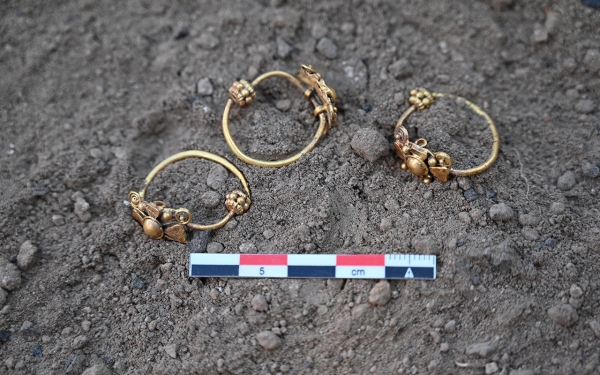

The archaeological jewelry finds in in the Kingdom of Saudi Arabia refer to adornments, necklaces, and amulets discovered in the Kingdom. Some discoveries were extracted from archaeological sites across the Kingdom, including Jawan and Thaj in the Eastern Province. Some of these items are adorned with gemstones, and date back to one hundred years BCE in Thaj, and from the first to the second century CE in Jawan.
Raw materials for ancient jewelry
The jewelry discovered in the Kingdom was crafted from materials such as shells, ostrich eggshells, feline teeth, ivory, pottery, colored stones, and various organic materials admired by ancient people for their supposed protective or lucky properties. Some of these items have been found at some archaeological sites.
Gemstones were also used in jewelry crafting for adornment and later for seals and for adorning royal crowns. Pearls and coral were sourced from the seas, while gold, silver, and copper were common in jewelry crafting.
Jewelry in the Islamic Age
Jewelry-making flourished during the Islamic age, including the Umayyad, Abbasid, and Ottoman periods. Women wore these jewelry during special occasions and weddings, and they were often given as gifts. The jewelry was made from gold and silver, and embellished with gemstones.
The generations inherited these forms of jewelry, their crafting, and wearing methods until recently in the Kingdom, especially in the central province, during the period between the seventeenth and the twentieth centuries. Jewelry during all periods of the Islamic age was, in all their metal or substance, free from human or animal figures or drawings, which were common in pre-Islamic jewelry.
Types of ancient jewelry found in Saudi Arabia
Among the notable ancient jewelry discoveries in the Kingdom are those made from bone, shell, and stone, used as worn amulets dating back to before the common era. A pottery bead necklace has been found at archaeological sites from the same BCE era. Additionally, a colored stone necklace was discovered in Buqayq and dates back to the third millennium BCE.
A necklace made of Yemeni agate (onyx) with parallel lines of brown and white was also found. It was brought as a raw material from Yemen and cut locally into beads. These beads were found in archaeological excavations in the Kingdom.
Furthermore, there is a gold necklace adorned with gemstones, including turquoise (known as "Dunq" or "al-Sharqi"), and pearl beads from the Eastern Province, Thaj, dating back to one hundred years BCE. Gold earrings with precious stones connected by a chain for decoration and securing the earrings from loss were discovered in Jawan in the Eastern Province and dated between one hundred and two hundred BCE.
Another notable discovery is a gold necklace from Thaj dating back to one hundred BCE, adorned with gemstones arranged around a stone shaped like a human face. In addition, there is a gold necklace decorated with pearls and gemstones, which was found in Jawan and dates back to the first or second century. Moreover, a decorative gold necklace adorned with gemstones was discovered in archaeological excavations in Jawan, dating back to around one hundred and two hundred BCE.
In the Islamic age, jewelry findings included crescent-shaped (Ashareq) adornments made from copper, possibly for headwear or necklaces, and red agate and glass beads from Islamic-era sites in the Kingdom.
Related quizzes
Related articles
